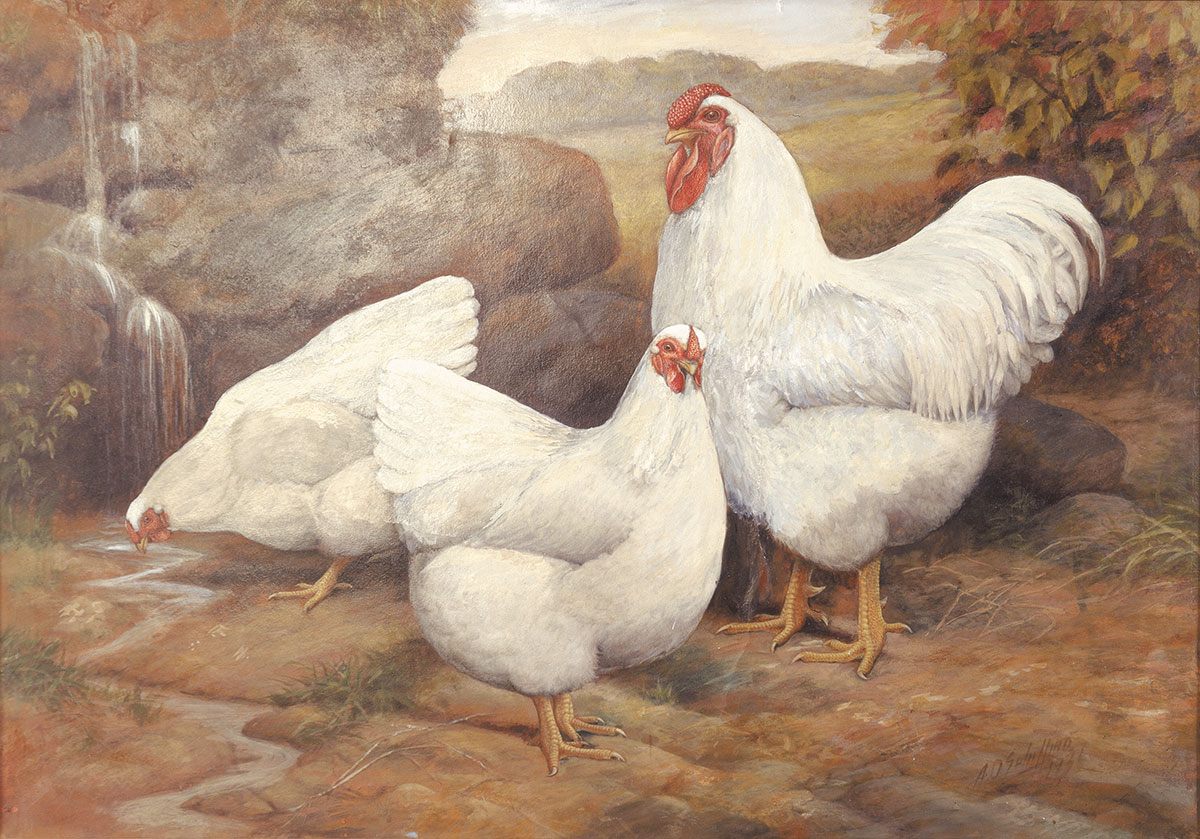The Poultry Pin-Up Art That Showed Off Breeders’ Best Chickens
Beautiful oil portraits of plump hens and roosters appeared in industry magazines for decades.

Daniel Webster, U.S. senator for the state of Massachusetts, showed a pair of Java chickens, a wild goose and some goslings at America’s first poultry show in November 1849. Held at Boston’s Public Garden, it allowed breeders to show off over 1,000 birds for the fame and awards that increased their flocks’ value. Gentlemen kept flocks of the latest and most beautiful breeds for bragging rights.
Only those who entered birds in the exhibition were allowed to give speeches, which the assembled crowd called upon Webster to do. As he began “Ladies and Gentlemen,” a Cochin rooster crowed with such determination that Webster gave up and sat down.
More than 10,000 spectators attended. The New England Historical Society called it “a red-letter day in the history of poultry breeding.”
During the next few decades, breeders got more organized, and in 1873 formed the American Poultry Association. In 1874, they produced the first Standard of Excellence, the bible of poultry exhibition. Each breed is precisely described, so that judges can compare birds for awards. But a picture is always worth a thousand words. Photographs in those early days were possible, but chickens are notoriously active and unwilling to pose. Besides, the Perfect Chicken doesn’t exist. Artists specializing in poultry filled the role of portraying, usually in oils, the Ideal Chicken of each breed.

Poultry keepers advertised their flocks, and awards, in poultry magazines such as the Poultry Tribune, which circulated to as many as 550,000 at its height. From 1926 onward, Publisher J. W. Watt and his partner Adon Yoder hired the top poultry artists of the 20th century—Arthur O. Schilling, Franklane L. Sewell, and Louis A. Stahmer—to create paintings of popular breeds, which were then featured in his monthly magazine. The artistic styles were different, each unique, but they captured the beauty and perfection of each breed. The paintings are so good that many are still used in the APA Standard of Perfection.
“Throughout the 1920s and ‘30s they were like pinups each month,” says Greg Watt, president and CEO of WATT Global Media, the company into which Watt Publishing Company has evolved.

The paintings, created between 1926-1950, were all displayed throughout the company corporate office buildings in Mt. Morris, Illinois until 2007. The company relocated to Rockford, Illinois that year. A few were displayed in the entrance lobby of the new headquarters. The rest of the collection was crated and placed in storage.
The collection includes those 58 paintings, of chickens, geese, turkeys, ducks, chicks and ducklings and guineafowl. For its centennial celebration, the company has arranged to exhibit the entire collection, August 11-26 at the Old Sandstone Art Gallery in Mt. Morris, Illinois. The building was Watt Publishing’s first home.
Andrea Gantz, associate editor for WATT Global Media, worked on an exhibit of 17 of the paintings in 2011 at Rockford Art Museum in Rockford, the current corporate headquarters. She keeps 12 hens in her yard.
“When we were opening the paintings, we could tell who painted what by looking at styles,” she says.
Rhode Island Reds, the state bird of Rhode Island, are still popular among backyard small flock keepers. The industrial Rhode Island Red is the breed used for commercial brown egg production. The birds in this painting by Schilling are quite different from the industrial strain that lays commercial brown eggs for the supermarket. They are bigger, fuller, with brighter, more consistent color.

Barred Plymouth Rocks, a color variety of the first breed listed in that original Standard in 1874, are often included in backyard flocks. Their portrait is painted by Schilling in the exhibit. Black Langshans, one of only three recognized Asiatic breeds, are now on the Livestock Conservancy’s Conservation Priority Watch list. That means there are fewer than 5,000 breeding birds in the United States, with 10 or fewer primary breeding flocks, and estimated global population of fewer than 10,000.
“These old breeds represent genetic diversity not found in today’s commercial and industrial brids,” says Jeannette Beranger, Senior Program Manager for the Livestock Conservancy. “With global warming and climate change, these are the breeds that can adapt. They are hardy, tough birds.”
Black and Single Comb Brown Leghorns are among Franklane Sewell’s portraits on exhibit. Robert Frost acknowledged Sewell’s artistry in his poem to his favorite hen, “A Blue Ribbon at Amesbury”: “In her we make ourselves acquainted/ With one a Sewell might have painted.”

Frost’s Mother Eve of chickens was a White Wyandotte, an American breed, shown in the exhibit in a painting by Schilling.
“Basically, the poultry industry up through the 1940s, when the paintings were first done, was more of a backyard enterprise,” says Charlie Olentine, former publisher, 1987-2004. “Back then, magazines meant going out to the farm level. Poultry Tribune was the main magazine. Now Watt’s magazines and audience served are all business to business.”
“He had a commitment to the poultry industry,” Jim Watt says of his grandfather. “Watt Publishing had its own poultry research farm. The National Turkey Federation arose out of the brainchild of one of the editors of Turkey World back then.”
Poultry producers sold birds with reputations as good egg layers, hefty meat producers, or as dual-purpose birds: good layers that were also big enough to put on the table. Hens were prized for their egg-laying ability. Young roosters, called cockerels, became fried chicken in the summer. Nothing went to waste.
Those concerns evaporated as the poultry industry turned to scientific and financial bottom-line management in the 1950s. The vertically integrated business model didn’t need artists and poultry shows to advance their products.
The Chicken of Tomorrow contest, started in 1945, was an indicator of that industry direction. The first recipient of the award was the Dark Cornish/New Hampshire cross, painted here by Schilling in 1950.

Several of the breeds pictured in the exhibit are no longer kept, and may be gone for good. Lamonas, a modern breed created for the market, are gone but dedicated breeders are attempting to re-create them. That’s possible, since they are a result of modern cross-breeding and their creators left records of what they did.
Hobby breeding can save rare breeds from extinction, but finding or creating a market for traditional breed poultry will generate economic conditions that give them a more secure future. If breeders can sell their birds and earn income, they will raise more of them. Having an economic purpose fulfills one of the original purposes of domestic poultry. The Standard of Perfection specifies Economic Value for most breeds.
“My barred rocks are marketable,” says Frank Reese of Good Shepherd Poultry Ranch in Lindsborg, Kansas, who won the American Treasures Award in 2012 for his work with heritage breed poultry. “They look like Barred Rocks were 70 years ago, when they were the meat bird … The old guys who wrote the standards didn’t write them to win shows. They wrote them so their birds would be productive.”
Current and former WATT employees attended the opening night reception to admire the paintings. Greg Watt said he had learned a lot about the breeds, and acquired a new appreciation for them.
“It was a magical evening,” he said. “I think we are looking at the tip of the iceberg.”

























Follow us on Twitter to get the latest on the world's hidden wonders.
Like us on Facebook to get the latest on the world's hidden wonders.
Follow us on Twitter Like us on Facebook